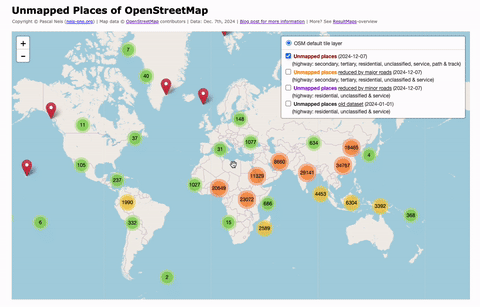Category: Stats
-

Unmapped Places of the OpenStreetMap World – 2024
In 2010, I first conducted a study which identified regions (places) in the OpenStreetMap (OSM) project in Germany that still had potential for more detailed mapping. Later, in 2016, this analysis was repeated and extended to the entire world. I have since regularly carried out these studies and published the results. The algorithm and some…
-
Review requests of OpenStreetMap contributors
– How you can assist! –The latest version of the OpenStreetMap editor iD has a new feature: “Allow user to request feedback when saving”. This idea has been mentioned in a diary post by Joost Schouppe about “Building local mapping communities” (at that time: “#pleasereview”) in 2016. The blog post also contains some…
-
Who is commenting?
An Overview about OSM Changeset DiscussionsAs mentioned in my previous blog post about detecting vandalism in OpenStreetMap (OSM) edits, it’s highly recommended that contributors use public changeset discussions when contacting other mappers regarding their edits. This feature was introduced at the end of 2014 and is used widely by contributors today. Each and every comment is listed publicly and every…
-
Detecting vandalism in OpenStreetMap – A case study
This blog post is a summary of my talk at the FOSSGIS & OpenStreetMap conference 2017 (german slides). I guess some of the content might be feasible for a research article, however, here we go: Vandalism is (still) an omnipresent issue for any kind of open data project. Over the past few years the OpenStreetMap…
-
A comparative study between different OpenStreetMap contributor groups – Outline 2016
Over the past few years I have written several blog posts about the (non-) activity of newly registered OpenStreetMap (OSM) members (2015, 2014, 2013). Similarly to the previous posts, the following image shows the gap between the number of registered and the number of active OSM members. Although the project still shows millions of new…
-
Verified OpenStreetMap contributor profiles?
The reputation of a contributor in OpenStreetMap (OSM) plays a significant role, especially when considering the quality assessment of the collected data. Sometimes it’s difficult …
-
How to detect suspicious OpenStreetMap Changesets with incorrect edits?
Since its rise in popularity, the well-known online encyclopedia Wikipedia has been struggling with manipulation or, in the worst-case, vandalism attempts. Similarly, the OpenStreetMap (OSM) project suffered several times over the past few years of cases where incorrect map data edits were made. These erroneous edits can stem at times from (new) contributors or illegal…
-
OpenStreetMap Crowd Report – Season 2015
Almost one year has passed again. This means it’s time for the fourth OpenStreetMap (OSM) member activity analysis. The previous editions are online here: 2014, 2013 and 2012 …
-
Counting changes per Country – A different approach
OSMstats contains several statistics about the OpenStreetMap (OSM) project, such as daily-created objects, the amount of active contributors or detailed numbers for individual countries. One way to determine the sum of created or modified Node objects, is to use …
-
Ebola Response Map and OSM contributor analysis
For almost eight months the OpenStreetMap (OSM) community has been collecting geo information for the West Africa Ebola outbreak response now. The collective work of the crowd is somewhat managed by the Humanitarian OpenStreetMap Team (HOT) …